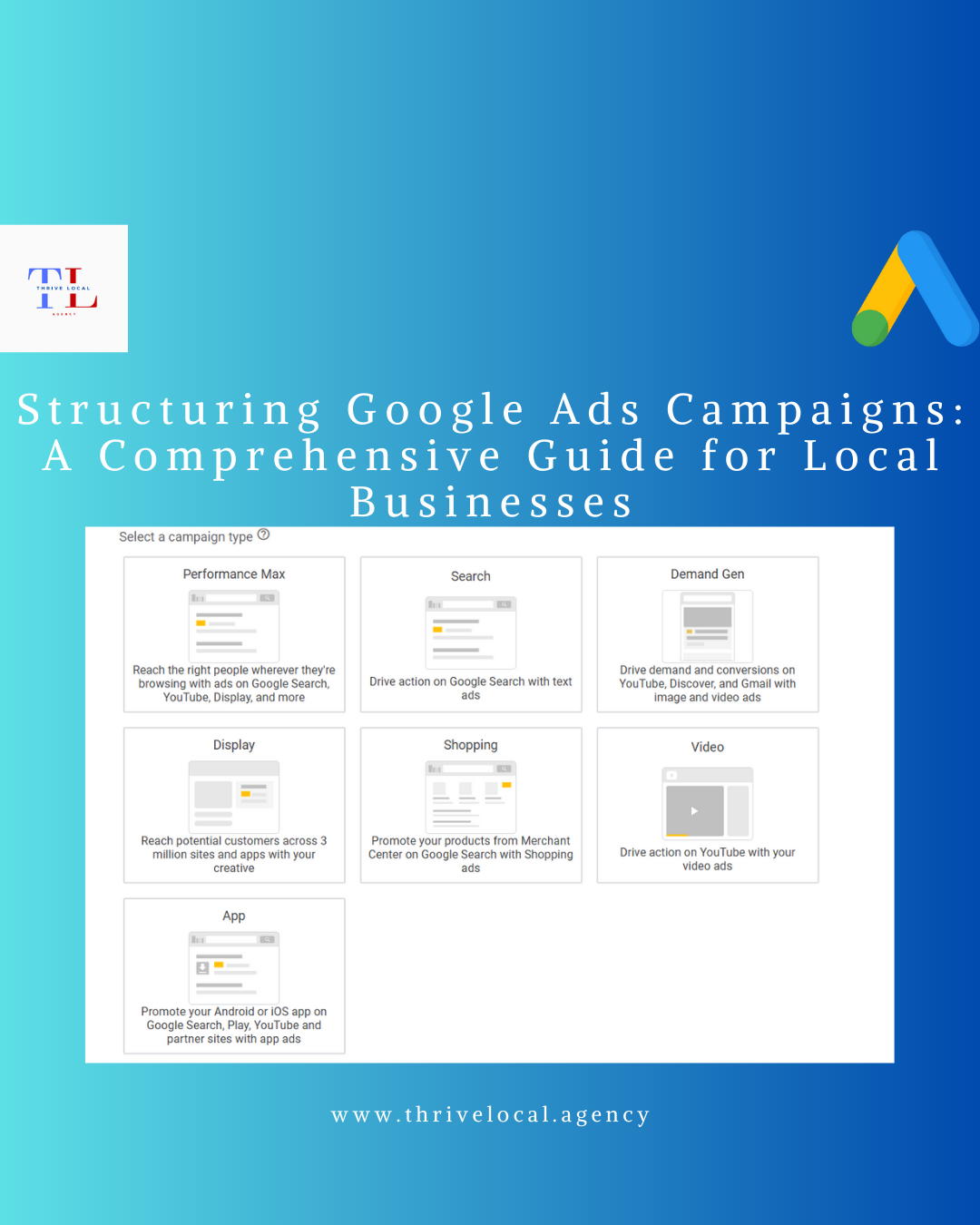In the dynamic world of digital advertising, structuring your Google Ads campaigns effectively is crucial for achieving your business objectives. This guide delves into the various campaign types available in Google Ads, their primary goals, functionalities, and how they can be leveraged by local businesses across different verticals.
🎯 Understanding Campaign Objectives
Google Ads campaigns are designed to align with specific marketing objectives. Selecting the right campaign type based on your goal ensures that your ads reach the appropriate audience through the most effective channels.
🧱 Structuring Your Google Ads Account
An organized account structure enhances manageability and performance. Here’s how to structure your campaigns:
- Campaign Level: Define overarching goals (e.g., brand awareness, lead generation).
- Ad Groups: Group related keywords and ads to target specific themes or products.Google Help+1DataFeedWatch+1
- Ads: Create compelling ad copies tailored to each ad group.
A well-structured account facilitates better tracking, optimization, and budget allocation.
📊 Exploring Google Ads Campaign Types
1. Search Campaigns
- Goal: Drive traffic through text ads appearing on Google search results.
- Functionality: Target users actively searching for specific keywords. This is intent-based advertising, as it captures users with a clear intent to find information or make a purchase.
- Example: A local bakery targeting “best birthday cakes in [City]” to attract customers searching for birthday cakes.
2. Display Campaigns
- Goal: Increase brand visibility through visual ads across Google’s Display Network.
- Functionality: Showcase image or responsive ads on websites, apps, and videos. This is interest-based advertising, reaching users based on their browsing behavior and interests, even if they aren’t actively searching for your product or service.
- Example: A home decor store displaying ads on interior design blogs to reach potential customers.
3. Shopping Campaigns
- Goal: Promote products directly within Google Shopping results.
- Functionality: Display product images, prices, and store information to users searching for specific items. Shopping campaigns are intent-based, targeting users actively looking to purchase products.
- Product Feeds: To run Shopping campaigns, businesses must create a product feed—a structured file containing product details like title, description, price, and availability—and upload it to Google Merchant Center. This feed enables Google to display accurate product information in ads.
- Example: An online electronics retailer showcasing the latest smartphones to users searching for “buy smartphones online.”
4. Video Campaigns
- Goal: Engage audiences through video content on YouTube and partner sites.
- Functionality: Run skippable or non-skippable video ads to promote products or services. This can be both interest-based and intent-based, depending on targeting settings.
- Example: A fitness center creating workout tip videos to attract health-conscious viewers.
5. App Campaigns
- Goal: Drive app downloads and engagement.
- Functionality: Automatically generate ads across Search, Play Store, YouTube, and Display Network using app assets.
- Example: A language learning app promoting its features to users interested in learning new languages.
6. Performance Max Campaigns
- Goal: Maximize performance across all Google channels using automation.
- Functionality: Leverage machine learning to optimize bids and placements across Search, Display, YouTube, and more. Performance Max campaigns can utilize product feeds from Google Merchant Center, similar to Shopping campaigns, to showcase products across various platforms.
- Example: An e-commerce store aiming to increase sales by reaching customers across multiple platforms with tailored ads.
7. Demand Gen Campaigns
- Goal: Create and convert new customer demand by reaching users across Google’s most visual and immersive platforms.
- Functionality: Demand Gen campaigns are designed to engage users before they actively search for your products or services. They leverage Google’s AI to deliver visually rich, multi-format ads across platforms like YouTube (including Shorts), Discover, and Gmail. These campaigns focus on interest-based targeting, utilizing audience signals such as interests, browsing behavior, and custom segments to connect with potential customers.
- Example: A local travel agency aiming to inspire potential customers can utilize Demand Gen campaigns to showcase captivating videos and images of vacation packages. By targeting users browsing travel-related content on YouTube Shorts, Gmail Promotions, and the Discover feed, the agency can generate interest and drive traffic to their offerings.
8. Local Services Ads
- Goal: Connect local service providers with nearby customers.
- Functionality: Feature verified professionals at the top of search results, allowing users to contact them directly.
- Example: A plumber appearing in searches for “emergency plumbing services near me.”
🛠️ Features Across Campaign Types
Each campaign type offers unique features tailored to specific objectives:
- Search: Keyword targeting, ad extensions, and responsive search ads.
- Display: Audience targeting, responsive display ads, and remarketing.
- Shopping: Product feed integration, merchant promotions, and local inventory ads.
- Video: Skippable/non-skippable ads, bumper ads, and video sequencing.
- App: Automated ad creation, targeting across multiple platforms, and performance optimization.
- Performance Max: Automated asset creation, cross-channel optimization, and goal-based targeting.
- Demand Gen: Visually rich ads, audience expansion, and feed-based placements.
- Local Services: Lead management, booking integration, and Google Guarantee badge.
🧩 Aligning Campaigns with Business Goals
Selecting the appropriate campaign type depends on your specific business objectives:
- Brand Awareness: Display, Video, and Discovery campaigns.
- Lead Generation: Search, Performance Max, and Local Services Ads.
- Sales: Shopping, Performance Max, and Search campaigns.
- App Promotion: App campaigns.Google Help+12helpcenter.channable.com+12Google+12
By aligning your campaign structure with your goals, you can optimize performance and achieve better ROI.
Implementing a well-structured Google Ads campaign tailored to your business objectives and industry can significantly enhance your online advertising effectiveness. Regularly reviewing and optimizing your campaigns ensures sustained success in the competitive digital landscape.
If you need further assistance in setting up or optimizing your Google Ads campaigns, feel free to ask!

